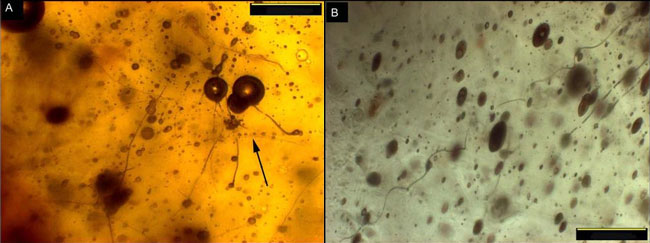Oldest Known Spider Webs Discovered

Silken spider webs dating back some 140 million years have been discovered preserved in amber, scientists announce today.
The viscous tree sap flowed over the spider webs before hardening and preserving the contents, which were discovered in Sussex, England. Other bits sealed up in the amber included plant matter, insect droppings and ancient microbes.
"These turn out to be the earliest webs that have ever been incorporated in the fossil record to our knowledge," said lead researcher Martin Brasier, a paleontologist at the University of Oxford.
Brasier and colleagues used a computer technique called confocal microscopy to reconstruct the webs and examine the interweaving silk threads. Various clues, including threads that were twisted and coated with sticky fluid droplets, suggest the webs were spun by spiders closely related to modern-day orb-web garden spiders.
"These spiders are distinctive and leave little sticky droplets along the spider web threads to trap prey," Brasier said. "We actually have the sticky droplets preserved within the amber."
The web analysis also gave insights about the spider's diet. "I would guess, from the form of the web, that it was feeding on flying insects like flies and the ancestors of bees, wasps and moths," Brasier told LiveScience.
In 2006, scientists reported an ancient web sealed in amber and estimated to be about 136 million years old.
Sign up for the Live Science daily newsletter now
Get the world’s most fascinating discoveries delivered straight to your inbox.
The new web discovery will be published in the latest issue of the Journal of the Geological Society.
- Images: Creepy Spiders
- Spider News, Information & Images
- Video – Psychedelic Spiders
Jeanna Bryner is managing editor of Scientific American. Previously she was editor in chief of Live Science and, prior to that, an editor at Scholastic's Science World magazine. Bryner has an English degree from Salisbury University, a master's degree in biogeochemistry and environmental sciences from the University of Maryland and a graduate science journalism degree from New York University. She has worked as a biologist in Florida, where she monitored wetlands and did field surveys for endangered species, including the gorgeous Florida Scrub Jay. She also received an ocean sciences journalism fellowship from the Woods Hole Oceanographic Institution. She is a firm believer that science is for everyone and that just about everything can be viewed through the lens of science.









